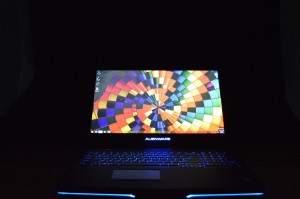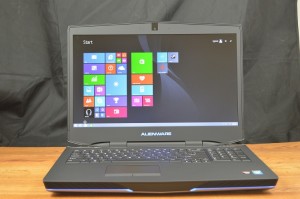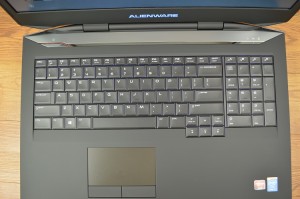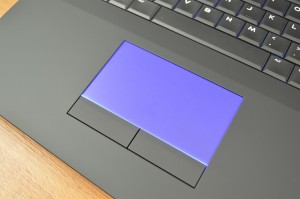Overview
The Alienware 17 is mostly unchanged since last year which isn’t a bad thing; it keeps the stealthy design, great build quality, AlienFX customizable lighting system and excellent gaming performance we praised it for previously. This iteration adds AMD’s flagship Radeon R9 M290X graphics card to the stable, which goes head to head with Nvidia’s GeForce GTX 860M and 870M offerings. The GTX 880M still rules the roost in raw graphics muscle, but AMD’s offering comes at a significantly lower price point.
Build and Design
Alienware notebooks make a strong statement when it comes to design; this is a package deal. Its stealth-like exterior has subtle but noticeable angles that create a futuristic appearance. There’s no hiding this notebook’s bulk, however; the Alienware 17 is nearly 10 pounds and just under two inches thick; a typical non-performance oriented 17.3″ notebook is about two-thirds the weight and thickness.
The AlienFX LED lighting system is user-customizable with multiple different lighting zones; the lid has two, the keyboard has four, the touchpad is one, the Alienware logo below is another the display and the final one is the strip around the chassis. Each zone can be set to a different color, to morph between two colors or be turned completely off. The AlienFX system can be completely turned off by pressing the [Fn] and [F12] keys simultaneously, a good idea while on battery to preserve power. Alienware debuted the AlienFX system in 2009 with the original Alienware m17x and we’ve been a fan of it ever since; it’s truly unique and keeps the ownership experience exciting.
The Alienware 17′s build materials consist of mostly plastic with touches of aluminum; the latter is found below the display hinge and comprises the entire back of the display. The display is impressively rigid and resists both flexing and twisting very well for its size. A strong lid design is important for protecting the display panel, especially if the notebook will see travel. The display’s hinge is stiff to the point where two hands are required to open the lid, but still operates very smoothly. The rest of the chassis is similarly rock solid; it’s nearly immune to flex and no part of the chassis surface gives way when applying pressure.
We like the soft-touch rubberized chassis surfaces; these conceal fingerprints and wear better over time than traditional plastic. Fit and finish is overall good with clean and consistent gaps between parts.
The Alienware 17 is user-upgradeable friendly, thanks to the large removable panel on the chassis bottom. This panel provides access to the memory modules (there are four total slots, all of which are occupied in our review unit’s 16GB configuration; 4x 4GB), both internal storage drives and the wireless card.
Input and Output Ports
The Alienware 17′s bulk allows it to include a multitude of ports including HDMI in and out, mini-DisplayPort, two headphone jacks and four USB 3.0 ports. All picture descriptions are left to right.
Left: AC power jack, Kensington lock slot, HDMI in/out, mini-DisplayPort, 2x USB 3.0, microphone, 2x headphone jack
Right: media card reader (top), slot-load optical drive (bottom), 2x USB 3.0, Ethernet
Screen and Speakers
Two resolutions are available on the Alienware 17: 1600×900 is standard and the higher 1920×1080 on our review unit is optional. Although it’s a TN-type panel, this display offers superb image quality. It has ample brightness and excellent contrast; black levels are strong. Color reproduction is very good with no lack of saturation without becoming excessive. The anti-glare display surface is welcomed; it produces no reflections in well-lit areas like displays with glossy surfaces. Viewing angles are vertically limited; the best image quality is found looking head on. Horizontal viewing angles are satisfactory with minimal shifts in color and brightness.

The 1920×1080 resolution is the highest offered on any 17.3″ notebook and is well worth the upgrade over the standard 1600×900 panel. Doing the math, 1920×1080 has 140% of the pixels and as a result displays a much finer level of detail in games, videos, and pictures. It’s also superior for productivity; you can easily use two windows side by side and won’t have to scroll as much in web pages and documents to see content.
The Alienware 17′s built-in Klipsch stereo speakers are located below the palm rest. These are a significant upgrade over standard notebook speakers with full sound and noticeable bass. They deliver sufficient volume to entertain a couple of people. It’s hard to expect more from a notebook. Remember, you can also get sound out of the Alienware 17 via its two static-free headphone jacks, HDMI, or mini-DisplayPort.
Keyboard and Touchpad
The Alienware 17′s full-size keyboard includes a separate numeric keypad and is backlit in a combination of any four colors you want. That’s right; the keyboard is split into four distinct lighting zones as part of the AlienFX LED lighting system. In addition to being able to change color, the zones can be set to pulse or morph between two colors. Other notebooks we’ve tested over the past several months have started offering different color keyboard backlighting, but none were as comprehensive as Alienware’s AlienFX solution.
We enjoy the Alienware 17′s typing experience. The keys have plenty of travel for good tactile response. The feel is cushioned and a bit rubbery but pleasant and quiet. There is no keyboard flex. The keyboard has a relatively standard layout with all of the expected keys. There are four additional user-programmable keys above the numeric keypad, which gamers will likely find useful (especially for MMO games). We like the rubberized surface on the keys because it hides fingerprints and should wear well over time.
The touchpad is properly sized for a 17.3-inch display and sits centered below the keyboard. It’s also an AlienFX lighting zone and can be changed to any color. We’re pleased that this is a traditional touchpad with two physical buttons as opposed to a clickpad where you press down anywhere to produce a click. This setup provides more reliable tactile feedback; the buttons provide a cushioned response with almost no noise. The touchpad’s anti-glare surface is easy to accurately track across.



0 comments:
Post a Comment